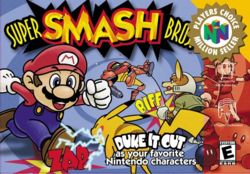Difference between revisions of "Super Smash Bros."
(→Legacy) |
|||
| Line 45: | Line 45: | ||
=Legacy= | =Legacy= | ||
| − | ''Super Smash Bros.'' quickly became one of Nintendo's most popular series. It has spawned sequels on all of Nintendo's major consoles, which | + | ''Super Smash Bros.'' quickly became one of Nintendo's most popular series. It has spawned sequels on all of Nintendo's major consoles, which have added Nintendo characters and eventually some third party characters to the fighting roster. |
==Ports/Remakes== | ==Ports/Remakes== | ||
| Line 53: | Line 53: | ||
==Sequels== | ==Sequels== | ||
| − | It was followed by ''[[Super Smash Bros. Melee]]'', which was released for the [[Nintendo Gamecube]] in 2001. | + | It was followed by ''[[Super Smash Bros. Melee]]'', which was released for the [[Nintendo Gamecube]] in 2001. The sequel added new characters, more items, new modes of play and the system of collectible trophies featuring even more parts of Nintendo's history. |
=See Also= | =See Also= | ||
Revision as of 07:32, 25 October 2018

| |
| Super Smash Bros. | |
| Developer | HAL Laboratory |
| Publisher | Nintendo |
| System | Nintendo 64 Wii Virtual Console |
| Release Date | Nintendo 64 JP January 21, 1999 US April 27, 1999 EU November 19, 1999 Wii Virtual Console JP January 20, 2008 EU/AU June 11, 2009 US December 21, 2009 |
| Gallery | GH Gallery |
| Rating | ESRB: E |
Super Smash Bros. is a crossover fighting game for the Nintendo 64 that was released in 1999 and features characters from various Nintendo series as playable fighters. It acts as the first game of the Super Smash Bros. series.
Story
The storyline is not implicitly stated , but the opening movie implies that Master Hand brings dolls of the various Mario characters to life and makes them battle.
Playable Characters
- Mario (from the Mario series)
- Donkey Kong (from the Donkey Kong series)
- Pikachu (from the Pokémon series)
- Yoshi (from the Mario and Yoshi series)
- Link (from the The Legend of Zelda series)
- Fox McCloud (from the Star Fox series)
- Samus Aran (from the Metroid series)
- Kirby (from the Kirby series)
The following are unlockable characters:
- Luigi (from the Mario series)
- Jigglypuff (from the Pokémon series)
- Ness (from EarthBound)
- Captain Falcon (from the F-Zero series)
Gameplay
Though every character fights differently, they have the same basic control scheme. The A button is used for regular attacks, while pressing the B button and a direction will unleash one of several special attack. The C^ button can is used to jump. Pressing the Z button will allow a character to grab another character and possibly throw them if someone is nearby; if no one is close enough, then a shield will be projected instead.
The 1 Player mode has the player fighting a series of individual battles against the other characters in the game. For variety, there are other types of battles such as Metal Mario, Fighting Polygon Team, and Giant Donkey Kong. Along with the battles, there are also three bonus games: Break the Targets, Board the Platform, and Race to the Finish. At the end, the player must battle Master Hand.
The game is renowned for its the multiplayer. Super Smash Bros. can be played by up to four players simultaneously. It supports a variety of different play modes including time, stock, and team options. There are also additional characters that can be unlocked by achieving different accomplishments in the game.
Legacy
Super Smash Bros. quickly became one of Nintendo's most popular series. It has spawned sequels on all of Nintendo's major consoles, which have added Nintendo characters and eventually some third party characters to the fighting roster.
Ports/Remakes
- In Japan, it was released for the Wii's Virtual Console in January 2009, while the other regions received later that year.
Sequels
It was followed by Super Smash Bros. Melee, which was released for the Nintendo Gamecube in 2001. The sequel added new characters, more items, new modes of play and the system of collectible trophies featuring even more parts of Nintendo's history.
See Also
| Titles in the Super Smash Bros. Series |
|---|
| Super Smash Bros. - Melee - Brawl - For Nintendo 3DS/Wii U - Ultimate |